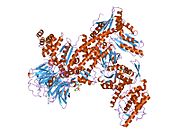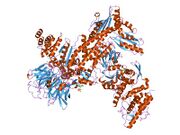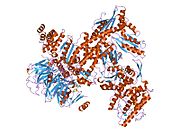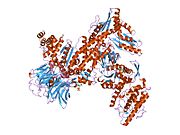Biology:ARPC1B
 Generic protein structure example |
Actin-related protein 2/3 complex subunit 1B is a protein that in humans is encoded by the ARPC1B gene.[1][2][3]
Function
This gene encodes one of seven subunits of the human Arp2/3 protein complex. This subunit is a member of the SOP2 family of proteins and is most similar to the protein encoded by gene ARPC1A. The similarity between these two proteins suggests that they both may function as p41 subunit of the human Arp2/3 complex that facilitates branching of actin filaments in cells. Isoforms of the p41 subunit may adapt the functions of the complex to different cell types or developmental stages.[3] Indeed, it has recently been shown that variants of the Arp2/3 complex differ in their ability to promote actin assembly, with complexes containing ARPC1B and ARPC5L being better at this than those containing ARPC1A and ARPC5.[4] The differing functions of ARPC1A and ARPC1B are also evident in the recent discovery of patients with severe or total ARPC1B deficiency, who have platelet and immune system abnormalities yet survive, possibly due to a compensatory up-regulation of ARPC1A expression.[5]
Interactions
ARPC1B has been shown to interact with PAK1.[6]
References
- ↑ "The human Arp2/3 complex is composed of evolutionarily conserved subunits and is localized to cellular regions of dynamic actin filament assembly". The Journal of Cell Biology 138 (2): 375–84. Jul 1997. doi:10.1083/jcb.138.2.375. PMID 9230079.
- ↑ "Mammalian actin-related protein 2/3 complex localizes to regions of lamellipodial protrusion and is composed of evolutionarily conserved proteins". The Biochemical Journal 328 ( Pt 1) (1): 105–12. Nov 1997. doi:10.1042/bj3280105. PMID 9359840.
- ↑ 3.0 3.1 "Entrez Gene: ARPC1B actin related protein 2/3 complex, subunit 1B, 41kDa". https://www.ncbi.nlm.nih.gov/sites/entrez?Db=gene&Cmd=ShowDetailView&TermToSearch=10095.
- ↑ Abella, Jasmine V. G.; Galloni, Chiara; Pernier, Julien; Barry, David J.; Kjær, Svend; Carlier, Marie-France; Way, Michael (2016). "Isoform diversity in the Arp2/3 complex determines actin filament dynamics". Nature Cell Biology 18 (1): 76–86. doi:10.1038/ncb3286. PMID 26655834. https://www.nature.com/ncb/journal/v18/n1/full/ncb3286.html.
- ↑ Kahr, Walter H. A.; Pluthero, Fred G.; Elkadri, Abdul; Warner, Neil; Drobac, Marko; Chen, Chang Hua; Lo, Richard W.; Li, Ling et al. (2017). "Loss of the Arp2/3 complex component ARPC1B causes platelet abnormalities and predisposes to inflammatory disease". Nature Communications 8: 14816. doi:10.1038/ncomms14816. PMID 28368018.
- ↑ "p41-Arc subunit of human Arp2/3 complex is a p21-activated kinase-1-interacting substrate". EMBO Reports 5 (2): 154–60. Feb 2004. doi:10.1038/sj.embor.7400079. PMID 14749719.
Further reading
- "A "double adaptor" method for improved shotgun library construction". Analytical Biochemistry 236 (1): 107–13. Apr 1996. doi:10.1006/abio.1996.0138. PMID 8619474.
- "Actin polymerization is induced by Arp2/3 protein complex at the surface of Listeria monocytogenes". Nature 385 (6613): 265–9. Jan 1997. doi:10.1038/385265a0. PMID 9000076.
- "Large-scale concatenation cDNA sequencing". Genome Research 7 (4): 353–8. Apr 1997. doi:10.1101/gr.7.4.353. PMID 9110174.
- "Lack of allelic exclusion in B cell chronic lymphocytic leukemia". The Journal of Experimental Medicine 185 (8): 1435–45. Apr 1997. doi:10.1084/jem.185.8.1435. PMID 9126924.
- "Interactions among subunits of human Arp2/3 complex: p20-Arc as the hub". Biochemical and Biophysical Research Communications 280 (2): 513–7. Jan 2001. doi:10.1006/bbrc.2000.4151. PMID 11162547.
- "Structure of Arp2/3 complex in its activated state and in actin filament branch junctions". Science 293 (5539): 2456–9. Sep 2001. doi:10.1126/science.1063025. PMID 11533442.
- "Crystal structure of Arp2/3 complex". Science 294 (5547): 1679–84. Nov 2001. doi:10.1126/science.1066333. PMID 11721045.
- "Reconstitution of human Arp2/3 complex reveals critical roles of individual subunits in complex structure and activity". Molecular Cell 8 (5): 1041–52. Nov 2001. doi:10.1016/S1097-2765(01)00393-8. PMID 11741539.
- "The acidic regions of WASp and N-WASP can synergize with CDC42Hs and Rac1 to induce filopodia and lamellipodia". FEBS Letters 514 (2–3): 168–74. Mar 2002. doi:10.1016/S0014-5793(02)02358-X. PMID 11943145.
- "Reduced expression of the insulin-induced protein 1 and p41 Arp2/3 complex genes in human gastric cancers". International Journal of Cancer 100 (1): 57–62. Jul 2002. doi:10.1002/ijc.10464. PMID 12115587.
- "Exploring proteomes and analyzing protein processing by mass spectrometric identification of sorted N-terminal peptides". Nature Biotechnology 21 (5): 566–9. May 2003. doi:10.1038/nbt810. PMID 12665801.
- "p41-Arc subunit of human Arp2/3 complex is a p21-activated kinase-1-interacting substrate". EMBO Reports 5 (2): 154–60. Feb 2004. doi:10.1038/sj.embor.7400079. PMID 14749719.
- "Decreased expression of the seven ARP2/3 complex genes in human gastric cancers". Cancer Letters 212 (2): 203–10. Aug 2004. doi:10.1016/j.canlet.2004.03.020. PMID 15279900.
- "Nucleolar proteome dynamics". Nature 433 (7021): 77–83. Jan 2005. doi:10.1038/nature03207. PMID 15635413. Bibcode: 2005Natur.433...77A.
External links
- ARPC1B human gene location in the UCSC Genome Browser.
- ARPC1B human gene details in the UCSC Genome Browser.
- Overview of all the structural information available in the PDB for UniProt: Q58CQ2 (Bovine Actin-related protein 2/3 complex subunit 1B) at the PDBe-KB.











